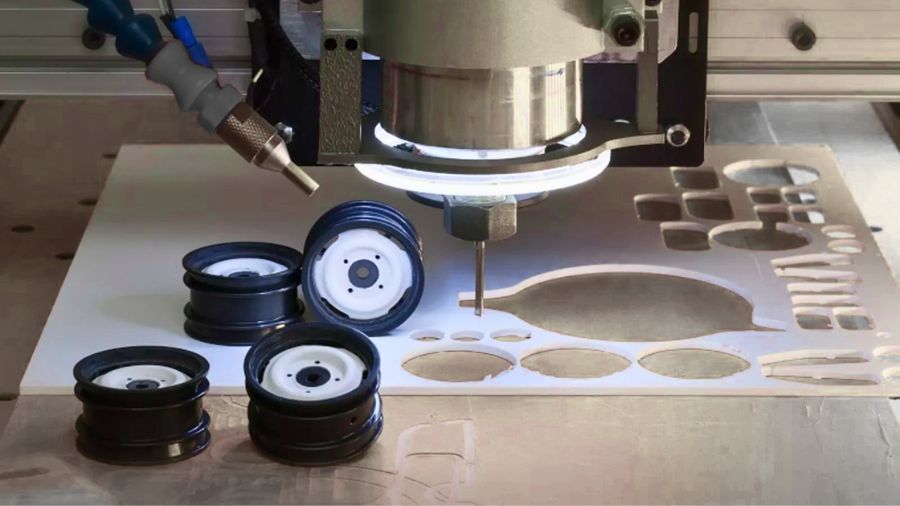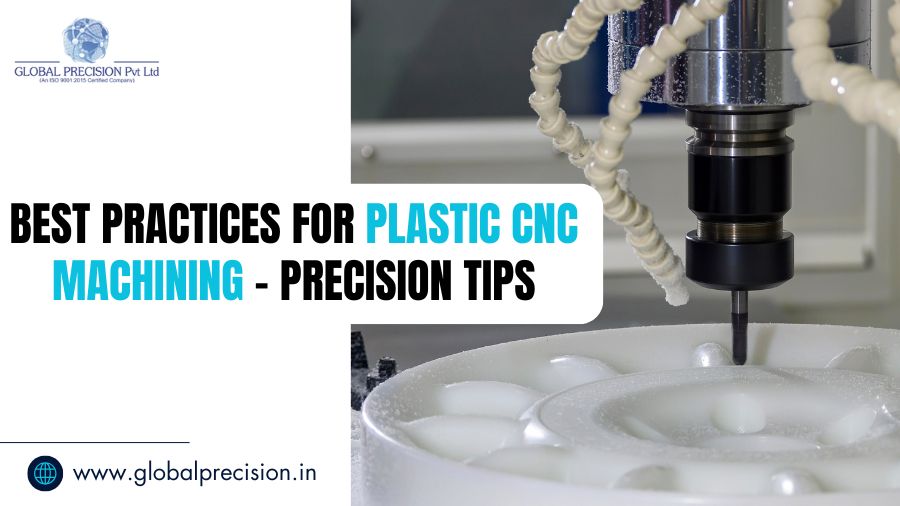In the world of advanced manufacturing, Precision machined components are the silent heroes strengthening everything from medical gadgets to aerospace systems. While metal usually dominates the conversation, plastic materials such as Acetal, PEEK, Nylon, and Acrylic are highly crucial, delivering benefits such as lightness, chemical resistance, and affordability. However, machining plastic to a high degree of accuracy shows remarkable difficulties that are fully different from working with metal.
Plastic CNC Machining is typically softer, more prone to thermal growth, and can deform effortlessly. Gaining tight tolerances and a seamless surface finish needs a customized system, one that comprehends that material’s character and adjusts the machining procedure accordingly.
At Global Precision Pvt. Ltd, a reliable CNC components manufacturer has expertise in high quality elements, we have grown a collection of major finest methods to constantly provide smooth CNC Milling components and turned elements from a broad range of polymers.
Table of Contents
Design For Machinability – The Foundation Of Precision

Precision begins long before the material block enters the machine. The structure stage is where up to 80% of manufacturing expenses and quality problems can be addressed. Following plastic-specific design rules makes sure your part isn’t only operational but also effortless and effective to the machine.
1. Mind the Wall Thickness
Plastics are less rigid than metals. If the walls of your structure are too thin, the force of the cutting equipment will cause the material to deflect or vibrate. This causes bad dimensional precision, a rough surface finish, and can even cause the part to warp or break.
Tip – For most plastics, set the target for a minimum wall thickness of around 1.5 mm. For high-performance, reinforced plastics, you may go smoothly thinner, but always examine the suggestions of the manufacturer. If you need a wall thinner than this, you should consult your CNC components manufacturer to check specialized fixturing or materials.
2. Optimize Internal Corners with Radii
A milling cutter is round, which means it can’t make an ideally sharp, 90° internal corner. Manufacturers usually ignore this, causing unwanted complications and expense. A sharp internal corner on a print forces the machinist to utilize a small tool, which is less rigid, more prone to breaking, and takes longer to function, decreasing the accuracy of the total element.
Tip – Develop all interval vertical corners with a radius. A better rule is to mention a corner radius that is around 130% of the cutter radius you plan to utilize. In case a near-sharp internal edge is highly required, think about a relief or undercut in that particular feature, which is usually easier to machine than trying to gain a minute radius in a big feature.
3. The Tolerance Trap – Only Tighten Where Necessary
It is tempting to mention ultra-tight tolerances in every dimension, but this is a basic error that drastically enhances expenses and leads to time without adding operational value. Tight tolerances need slower cutting paces, several finishing passes, and costly, time-consuming verification procedures.
Tip – Reserve your strong tolerances only for the most crucial factors, like mating surfaces or bore diameters. For all other, non-critical features, utilize the common machining tolerance. This balance makes sure your Precision machined components are affordable while sustaining operational integrity.
Material Mastery – Understanding Plastic’s Unique Traits
Successfully machining plastic depends on treating it not as soft metal, but as a distinctly different material. Key to this is handling heat and internal stresses.
1. The Problem of Heat – Melting and Expansion
The major distinction between metal and plastic cnc machining is the way plastics manage heat. Plastics have a much lower melting point and a higher Coefficient of Thermal Expansion. The friction from the cutting equipment can quickly produce heat, leading to material to –
- Melt or Smear – Causing a strong, bad surface finish and material merging to the equipment.
- Expand – Leading to the part to be dimensionally precise while hot, but undersized once it cools down and contracts. This is a typical reason for failure in extremely precise CNC components.
Tip – Utilize equipment with a high positive rake angle. A sharp corner cuts the material properly, decreasing the friction and rubbing that produce heat. The most useful coolant for plastics is typically a high-pressure jet of compressed air. This not only cools the component but also quickly evacuates chips, controlling them from melting back into the material or re-cutting.
2. Stress Management – Annealing to Prevent Warping
Several plastics, particularly those such as Acetol and Nylon, have built-in internal stresses from their manufacturing procedure. When a remarkable amount of material is eliminated throughout CNC milling components invention, these forces can be released unevenly, leading to the finished component bending, bowing, or warping out of tolerance.
Tip – For high-accuracy components, particularly with tight tolerances and big material removal, annealing before the final machining passes is crucial. Annealing relaxes the material, stabilizing its measurement and drastically decreasing the chance of warpage.
Tooling and Programming Strategies
This section would comprise the particular tools and settings vital for plastic cnc machining –
1. Tool Material and Geometry –
- Carbide vs. HSS – When to utilize which. High-speed steel for softer plastics vs. Carbide for reinforced plastics.
- Single-Flute Cutters – Why they are the champion for several plastics.
- Polishing Flutes – The significance of a polished flute for a seamless surface finish.
2. Cutting Parameters –
- High Speed, High Feed – The cut fast and get out, philosophy to control heat buildup.
- Feed Rate for Finish – Utilizing a high feed rate to make sure the tool is always cutting, not rubbing, which is important for a flawless surface on precision machined components.
3. Chip Control – A big difficulty of plastic chips, melting, sticking, and re-cutting. Solutions such as air-blast, vacuum systems, and particular tool paths.
Fixturing and Quality Control
Holding the part and confirming the accuracy are the main goals of this section.
- Minimal Clamping Force – How to clamp without causing the softer material to deform is known as minimal clamping force. Employing vacuum fixtures, toe clamps, or specialized soft jaws. The CNC components’ dimensional accuracy is destroyed by excessive pressure.
- Preventing Vibration – A rigid setup is essential to prevent chatter, which is a major hindrance to CNC milling components’ precision and surface finish.
Measurement and Metrology –
- Temperature Compensation – To compensate for the high CTE of plastic, the part is measured at a regulated, standard temperature, typically $20^{\circ}$C.
- Using Non-Contact Metrology – The advantage of laser measurement or vision systems for extremely precise, flexible parts that could distort when probed with a conventional tool.
Post-Processing and Finishing – The Final Polish
What occurs after the machining is finished is described in this section.
1. Deburring – Because small burrs can still be left by sharp tools, plastic must be deburred manually or automatically. Alternatives such as hand scraping, media blasting (using glass beads, for example), or chemical cleaning.
2. Obtaining Optical Clarity – Particular procedures for transparent polymers such as polycarbonate and acrylic. The compromise between additional polishing steps and the as-machined finish.
3. Cleaning and Storage – Incompatible cleaners or coolants may cause chemical stress cracking in some plastics (such as polycarbonate). Appropriate storage (e.g., for nylon) to avoid moisture absorption.
Partner with the Experts – Global Precision Pvt Ltd

As a top manufacturer of CNC components, Global Precision Pvt Ltd has established a solid reputation for decades by providing top-notch precision machined components all over the world. Our staff is aware that plastic cnc machining is a science that calls for the purchase of the appropriate equipment, cutting-edge tools, and—above all—skill.
Working with us guarantees that your project takes advantage of these tried-and-true best practices, whether you require complex CNC milling components for a new medical device or high-volume parts for the automotive industry. To ensure that you receive components that are accurate, dependable, and delivered on schedule, we handle the complexity of heat control, stress relief, and tight tolerances.

